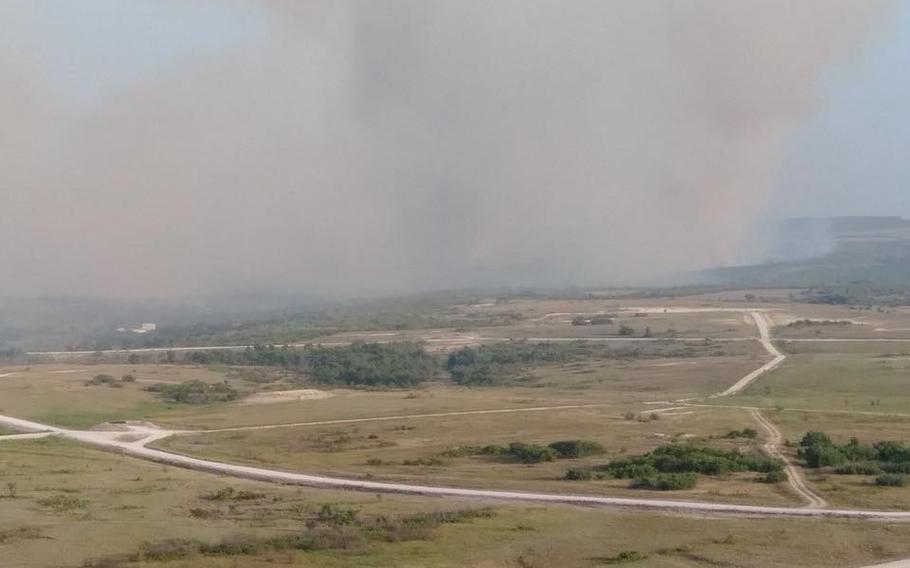
A wildfire at Fort Hood, Texas has created a pause in live-fire training at the Army installation there. The fire has been burning for about four days and covers about 6,500 acres of the sprawling 108,000-acre post, officials said. (Fort Hood Fire & Emergency Services)
AUSTIN, Texas — Live-fire gunnery exercises remain suspended until further notice at Fort Hood as wildfires continue to burn on the Army post’s expansive training grounds.
The pause in training allows firefighters more flexibility to conduct safer air and ground operations, according to a release from the Army installation. As of Wednesday, the fire has been burning for about five days and had grown to cover about 8,500 acres of the sprawling 214,000-acre post, officials said, adding it poses no immediate risk of leaving the installation boundary or threatening life or property.
Officials described the area burning as an isolated training area of the post.
Extreme heat and dry weather has created the ideal environment for wildfires across Texas, and conditions are expected to continue for the next several days. An overnight shift in the wind Monday into Tuesday lowered temperatures at Fort Hood from 111 degrees to 99 degrees. The drier, northern wind also enabled this wildfire to expand.
Last week, small grass fires had ignited within a closed part of the training area, the Army release stated. This area can contain unexploded ordnance from the many tanks and combat vehicles used in training there.
The intense heat during the past week also has impacted firefighting operations.
“The record heat and extreme dry conditions have created intense fire behavior, thus making it a challenge to extinguish fires,” said Bob Adams, chief of operations for the Fort Hood Directorate of Emergency Services. “The fires are burning extremely hot and burn the dry vegetation very quickly.”
Despite the cancellation of live-fire exercises, units have been able to accommodate the schedule adjustments, working other skills in the interim, said Chris Haug, a Fort Hood civilian spokesman. It is not impacting their readiness to deploy, he said.
Multiple agencies are responding to the fire alongside the Fort Hood Fire Department, including the Air National Guard, engineer, aviation and combat units from Fort Hood and helicopters from the Royal Netherlands Air Force, which utilizes Fort Hood as a training base.
Throughout Wednesday, six helicopters conducted aerial fire suppression and six military bull dozers conducted offensive and defensive operations to suppress and contain the fires, according to a release. This was expected to continue from sunrise to sunset.
Since the fires began, more than 60,000 work hours have been dedicated to fighting the blazes in the impact area, Adams said. As firefighting operations continue, heat has been a safety concern for Fort Hood senior leaders.
“Until we get significant soaking rains, which we’re not seeing for next seven days, we’ll continue to see conditions stay dry out there,” said Jason Godwin, a meteorologist with National Weather Service in Fort Worth.
Texas State Forestry Service was providing water and fire-retardant drops, though their crews left the installation over the weekend to tackle larger fires elsewhere in Texas — most of them in the central and eastern areas. There were three wildfires listed as actively burning Wednesday and nearly two dozen more listed as recently contained, according to the Texas A&M Forest Service.
Wildfires and grass fires are a concern each summer within the training areas of Fort Hood, located in central Texas, about an hour’s drive north of Austin. Most of them are far from the main post population, though when they occur in an area containing unexploded ordnance, also known as the impact area, they can be difficult to fight.
To prepare for the season, Fort Hood officials conduct prescribed burns and coordinate with surrounding area officials on training and communication.
“Mutual aid agreements are very important to Fort Hood and the surrounding local communities,” Adams said. “It allows the sharing of resources and personnel to quickly and effectively attack fires. Last week, Fort Hood did support off the installation firefighting efforts. However, at this time, all Fort Hood fire assets are assigned to the Fort Hood fire. We have received assistance from both state and local fire assets in support of the Fort Hood fire, which have greatly help our efforts. Times like these highlight the importance of our fire mutual aid agreements and the greater importance of our partnerships with the local community.”
On Tuesday, Col. Hank Perry, the garrison commander, conducted a reconnaissance flight to get the scope of the situation.
“(It) proved to me just how widespread the fires became, how difficult the terrain is for our firefighters, how professional our aviators are in conducting their missions, and just how important it is that we conduct prescribed burns year-round to reduce [brush] so that we can train continuously,” Perry said, noting since November the installation conducted prescribed burns affecting more than 21,000 acres.
Fort Hood is home to 36,000 soldiers and about 45,000 military dependents living in the surrounding communities. It’s the Army’s largest armored post and home to the 1st Cavalry Division. Fort Hood’s commanding headquarters, III Corps, is now deployed to Baghdad, Iraq, as the headquarters of Combined Joint Task Force-Operation Inherent Resolve.
thayer.rose@stripes.com Twitter: @Rose_Lori